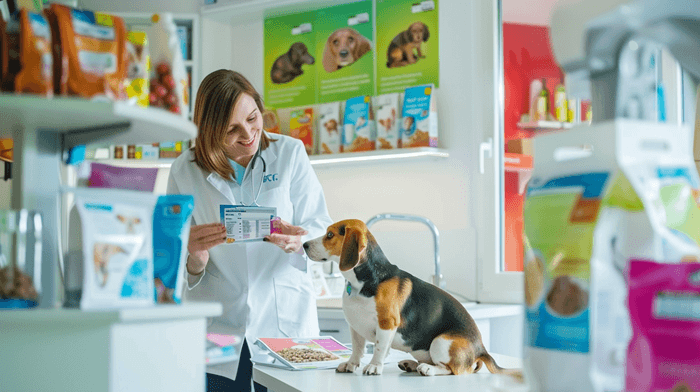
Choosing the right best food for your dog is one of the most important decisions you can make as a pet owner. With the plethora of options available on the market, it can be overwhelming to determine what’s best for your furry friend. A balanced and nutritious diet is essential for your dog’s overall health, longevity, and happiness. This article aims to provide you with practical guidance on how to choose the best dog food tailored to your pet’s age, size, and specific needs. By the end of this guide, you will be equipped with the knowledge necessary to make informed decisions about your dog’s nutrition, ensuring they lead a healthy and fulfilling life.
The Importance of Choosing the Right Best Dog Food

1. Health Benefits
The right diet plays a crucial role in maintaining your dog’s health. A balanced diet can help prevent obesity, diabetes, and other health issues. Proper nutrition supports a strong immune system, promotes healthy skin and coat, and aids in digestion. Ensuring that your dog receives the right nutrients can lead to a longer, happier life.
2. Age-Appropriate Nutrition
Dogs have different nutritional needs based on their life stage. Puppies require a diet rich in protein and calories to support their rapid growth and development, while adult dogs may need a more balanced diet to maintain their health. Senior dogs, on the other hand, often require fewer calories but more nutrients to support their aging bodies. Ignoring these differences can lead to health problems down the line.
3. Weight Management
Obesity is a significant issue among dogs, leading to various health problems. Choosing the right food can help you manage your dog’s weight effectively. Foods specifically formulated for weight control are available, and understanding your dog’s caloric needs based on their size and activity level is essential for maintaining a healthy weight.
4. Allergy and Sensitivity Considerations
Many dogs suffer from food allergies or sensitivities. Choosing the right best food can alleviate these issues and improve your dog’s quality of life. If your dog shows signs of allergies, such as itching, gastrointestinal upset, or skin issues, it’s vital to identify the offending ingredient and select a suitable alternative.
5. Behavioral Benefits
Believe it or not, a dog’s diet can affect its behavior. Foods rich in omega-3 fatty acids, for instance, can promote brain health and may help with anxiety or behavioral issues. Proper nutrition contributes to overall well-being, which can result in a happier, more balanced pet.
How to Choose the Right Best Food for Your Dog
Step 1: Understand Your Dog’s Nutritional Needs
Before selecting a dog best food, it’s essential to understand your dog’s specific nutritional needs. Factors such as age, size, breed, and activity level play significant roles in determining the right diet.
- Puppies: Require high-protein, high-calorie diets to support growth.
- Adults: Need balanced nutrition to maintain health and energy.
- Seniors: Often need diets lower in calories but higher in fiber and nutrients.
Step 2: Read the Ingredients List
When choosing dog best food, always start with the ingredients list. Look for high-quality protein sources, such as meat or fish, listed as the first ingredient. Avoid foods with vague terms like «meat by-products» or «animal meal.»
Key Ingredients to Look For:
- Protein: Essential for muscle maintenance and energy.
- Fats: Provide energy and support healthy skin and coat.
- Carbohydrates: Serve as a source of energy, but should not dominate the ingredient list.
- Vitamins and Minerals: Important for overall health and well-being.
Step 3: Consider Your Dog’s Specific Needs
Every dog is unique, and their food should reflect that. Consider any specific health issues, allergies, or dietary restrictions your dog may have. Consult with your veterinarian for personalized recommendations.
Step 4: Evaluate the Brand’s Reputation
Not all dog best food brands are created equal. Research the brand’s reputation, manufacturing practices, and ingredient sourcing. Look for brands that prioritize quality and transparency.
Step 5: Transition Slowly
Once you’ve chosen a new food, transition your dog gradually over a week to prevent digestive upset. Start by mixing a small amount of the new food with their current food, gradually increasing the proportion of the new food.
Step 6: Monitor Your Dog’s Health
After transitioning to a new food, monitor your dog’s health and behavior. Look for changes in energy levels, coat quality, and digestion. If you notice any adverse effects, consult your veterinarian.
Common Mistakes to Avoid When Choosing Dog Food
1. Not Considering Life Stage
One of the most common mistakes dog owners make is not considering their dog’s life stage. Puppies, adults, and seniors have different nutritional requirements. Ignoring these differences can lead to health issues. For instance, senior dogs may require fewer calories and more nutrients for joint health.
2. Ignoring Food Allergies
Not all dogs are the same, and some may have food allergies. Ignoring signs of allergies, such as itching, redness, or digestive problems, can result in unnecessary suffering for your pet. If you suspect your dog has allergies, consult your veterinarian and consider a hypoallergenic diet.
3. Failing to Research Brands
With so many brands on the market, some owners choose popular brands without researching their quality. It’s essential to know the brand’s reputation and the ingredients they use. An article from Petfood Industry highlights the importance of researching and choosing brands that prioritize quality and ingredient transparency.
4. Not Paying Attention to Specific Needs
Every dog is unique, with specific nutritional requirements. Ignoring factors like breed, size, age, and activity level can lead to health issues. An active dog may require more calories than a less active one, while large breeds may need diets that promote joint health.
5. Sticking to One Food
Many dog owners stick to the same food for years, thinking it’s the best choice. However, as dogs age, their nutritional needs change. Regularly reassessing your dog’s diet and adjusting accordingly is crucial for their health.
Scientific Backing for Proper Dog Nutrition

Studies on Dog Nutrition
Research consistently shows the significance of proper nutrition in canine health. A study published in the Journal of Animal Science emphasizes that a balanced diet can improve the overall health and lifespan of dogs. Nutritional deficiencies can lead to severe health issues, including obesity, diabetes, and heart disease.
Importance of High-Quality Ingredients
According to a study in the Veterinary Journal, the quality of ingredients directly affects a dog’s health. High-quality proteins and fats support muscle growth, energy levels, and coat health. Dogs fed a balanced diet rich in essential nutrients exhibited fewer health problems compared to those on lower-quality diets.
Links Between Nutrition and Behavior
Research from the University of Pennsylvania School of Veterinary Medicine suggests that proper nutrition can influence behavior in dogs. Diets rich in omega-3 fatty acids may help reduce anxiety and behavioral issues, while diets lacking essential nutrients can lead to hyperactivity and aggression.
Conclusion

Choosing the best food for your dog is a responsibility that should not be taken lightly. The health and well-being of your pet depend on proper nutrition. Through careful research, consultations with veterinarians, and continuous evaluation of your dog’s diet, you can ensure your furry friend is well-fed and happy. Remember, investing in the right nutrition is investing in your pet’s long-term health.
If you’re ready to provide your dog with the best possible nutrition, consider exploring quality best food options on the market. You can also look into educational resources on canine nutrition, which offers valuable information on dog feeding and well-being. Don’t wait any longer to improve your four-legged companion’s health!
